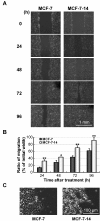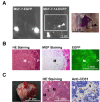Nuclear beta-catenin and CD44 upregulation characterize invasive cell populations in non-aggressive MCF-7 breast cancer cells
- PMID: 20696077
- PMCID: PMC3087322
- DOI: 10.1186/1471-2407-10-414
Nuclear beta-catenin and CD44 upregulation characterize invasive cell populations in non-aggressive MCF-7 breast cancer cells
Abstract
Background: In breast cancer cells, the metastatic cell state is strongly correlated to epithelial-to-mesenchymal transition (EMT) and the CD44+/CD24- stem cell phenotype. However, the MCF-7 cell line, which has a luminal epithelial-like phenotype and lacks a CD44+/CD24- subpopulation, has rare cell populations with higher Matrigel invasive ability. Thus, what are the potentially important differences between invasive and non-invasive breast cancer cells, and are the differences related to EMT or CD44/CD24 expression?
Methods: Throughout the sequential selection process using Matrigel, we obtained MCF-7-14 cells of opposite migratory and invasive capabilities from MCF-7 cells. Comparative analysis of epithelial and mesenchymal marker expression was performed between parental MCF-7, selected MCF-7-14, and aggressive mesenchymal MDA-MB-231 cells. Furthermore, using microarray expression profiles of these cells, we selected differentially expressed genes for their invasive potential, and performed pathway and network analysis to identify a set of interesting genes, which were evaluated by RT-PCR, flow cytometry or function-blocking antibody treatment.
Results: MCF-7-14 cells had enhanced migratory and invasive ability compared with MCF-7 cells. Although MCF-7-14 cells, similar to MCF-7 cells, expressed E-cadherin but neither vimentin nor fibronectin, beta-catenin was expressed not only on the cell membrane but also in the nucleus. Furthermore, using gene expression profiles of MCF-7, MCF-7-14 and MDA-MB-231 cells, we demonstrated that MCF-7-14 cells have alterations in signaling pathways regulating cell migration and identified a set of genes (PIK3R1, SOCS2, BMP7, CD44 and CD24). Interestingly, MCF-7-14 and its invasive clone CL6 cells displayed increased CD44 expression and downregulated CD24 expression compared with MCF-7 cells. Anti-CD44 antibody treatment significantly decreased cell migration and invasion in both MCF-7-14 and MCF-7-14 CL6 cells as well as MDA-MB-231 cells.
Conclusions: MCF-7-14 cells are a novel model for breast cancer metastasis without requiring constitutive EMT and are categorized as a "metastable phenotype", which can be distinguished from both epithelial and mesenchymal cells. The alterations and characteristics of MCF-7-14 cells, especially nuclear beta-catenin and CD44 upregulation, may characterize invasive cell populations in breast cancer.
Figures







Similar articles
-
SLUG/SNAI2 and tumor necrosis factor generate breast cells with CD44+/CD24- phenotype.BMC Cancer. 2010 Aug 6;10:411. doi: 10.1186/1471-2407-10-411. BMC Cancer. 2010. PMID: 20691079 Free PMC article.
-
Prolonged drug selection of breast cancer cells and enrichment of cancer stem cell characteristics.J Natl Cancer Inst. 2010 Nov 3;102(21):1637-52. doi: 10.1093/jnci/djq361. Epub 2010 Oct 8. J Natl Cancer Inst. 2010. PMID: 20935265 Free PMC article.
-
Generation of MCF-7 cells with aggressive metastatic potential in vitro and in vivo.Breast Cancer Res Treat. 2014 Nov;148(2):269-77. doi: 10.1007/s10549-014-3159-4. Epub 2014 Oct 8. Breast Cancer Res Treat. 2014. PMID: 25292421
-
Epithelial mesenchymal transition traits in human breast cancer cell lines parallel the CD44(hi/)CD24 (lo/-) stem cell phenotype in human breast cancer.J Mammary Gland Biol Neoplasia. 2010 Jun;15(2):235-52. doi: 10.1007/s10911-010-9175-z. Epub 2010 Jun 4. J Mammary Gland Biol Neoplasia. 2010. PMID: 20521089 Review.
-
Prognosis assessment of CD44+/CD24- in breast cancer patients: a systematic review and meta-analysis.Arch Gynecol Obstet. 2022 Oct;306(4):1147-1160. doi: 10.1007/s00404-022-06402-w. Epub 2022 Apr 18. Arch Gynecol Obstet. 2022. PMID: 35435483
Cited by
-
Dietary ω -3 polyunsaturated fatty acid DHA: a potential adjuvant in the treatment of cancer.Biomed Res Int. 2013;2013:310186. doi: 10.1155/2013/310186. Epub 2013 May 23. Biomed Res Int. 2013. PMID: 23762838 Free PMC article. Review.
-
CD44 Promotes Breast Cancer Metastasis through AKT-Mediated Downregulation of Nuclear FOXA2.Biomedicines. 2022 Oct 5;10(10):2488. doi: 10.3390/biomedicines10102488. Biomedicines. 2022. PMID: 36289750 Free PMC article.
-
CD44 correlates with clinicopathological characteristics and is upregulated by EGFR in breast cancer.Int J Oncol. 2016 Oct;49(4):1343-50. doi: 10.3892/ijo.2016.3639. Epub 2016 Jul 29. Int J Oncol. 2016. PMID: 27499099 Free PMC article.
-
Synchronous peritoneal carcinomatosis from a buccal squamous cell carcinoma: a case report focusing on possible metastatic mechanisms and novel therapeutic modalities.Ecancermedicalscience. 2019 Jul 29;13:954. doi: 10.3332/ecancer.2019.954. eCollection 2019. Ecancermedicalscience. 2019. PMID: 31645882 Free PMC article.
-
Multi-modal liquid biopsy platform for cancer screening: screening both cancer-associated rare cells and cancer cell-derived vesicles on the fabric filters for a reliable liquid biopsy analysis.Nano Converg. 2019 Nov 15;6(1):39. doi: 10.1186/s40580-019-0204-3. Nano Converg. 2019. PMID: 31728677 Free PMC article.
References
-
- Chu YW, Yang PC, Yang SC, Shyu YC, Hendrix MJ, Wu R, Wu CW. Selection of invasive and metastatic subpopulations from a human lung adenocarcinoma cell line. Am J Respir Cell Mol Biol. 1997;17:353–360. - PubMed
Publication types
MeSH terms
Substances
LinkOut - more resources
Full Text Sources
Medical
Research Materials
Miscellaneous

